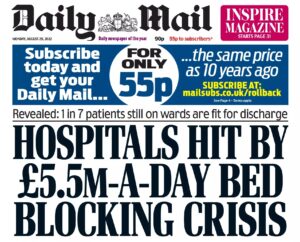Providing a Solution to Help Reduce Bed Blockers and Delayed Discharge
 What is the solution for Bed Blockers? It’s a strange way to start a web page but it’s the reason you are here.
What is the solution for Bed Blockers? It’s a strange way to start a web page but it’s the reason you are here.
The term ‘bed blocker’ has been highlighted in the media and is quickly becoming a large portion of avoidable expense in NHS. The solution for bed blocking can only be found if we address and understand what exactly is a ‘bed blocker’.
A ‘bed blocker’ is shorthand for someone who is unable to leave hospital and return to their own home, even though they do not need medical treatment or care. Some people are considering the phrase ‘bed blocker’ is a derogatory term that fails to take account of the fact that it is a person who is being talked about and it is sometime a personal circumstance that has cause the situation they are now facing.

Terms like delayed discharge are now being used. Although conveying the same information, this can be seen to be less judgmental of the person involved than a ‘bed blocker’.
The issue with a delayed discharge is that there are a finite number of beds available in a particular hospital. Some hospitals have reported that up to 10% of their beds are occupied by those unable to be discharged for non-medical reasons. This is often the reason that delayed discharge is in the news.
Having fewer beds available means that routine operations are cancelled because there is no bed available or that patients have to wait on trolleys in A & E for long periods while a bed can be found for them. This has resulted in some hospitals declaring emergency measures, which then becomes a news story.
Various studies have shown that the overwhelming majority of people who are unable to be discharged are older people and that there are many reasons why they cannot be discharged. Some will require additional care and/or treatment that is provided by their GP; or at outpatient clinic; or by nurses who visit them in their own homes and are waiting for this to be arranged.
In itself the delayed discharge of patients should not be seen as evidence that the NHS is failing. It is a problem, and it is one that needs to be addressed. It is often the interface between the health service and social services that contributes to the issue, and it is this that needs to be addressed. The lack of social care for older people, whether this relates to places in care homes or services that assist older people to live in their own homes, is a major contributing factor to delayed discharge.
 Care for patient outside of the hospital needs to be reviewed so that, when a patient is medically fit to be discharged, the other services that are needed can be put into place for them. This is what Ready4Home are working on. We provide that vital solution on how to help reduce Delayed Discharge.
Care for patient outside of the hospital needs to be reviewed so that, when a patient is medically fit to be discharged, the other services that are needed can be put into place for them. This is what Ready4Home are working on. We provide that vital solution on how to help reduce Delayed Discharge.
A delayed discharge is not just a problem for the NHS who cannot admit another patient into that bed, it is also a problem for the person who is unable to leave hospital and return to their own life.
